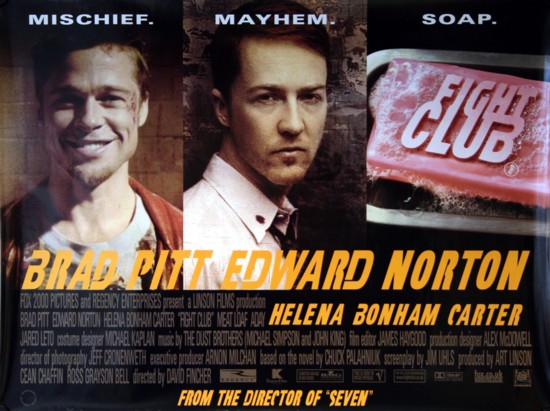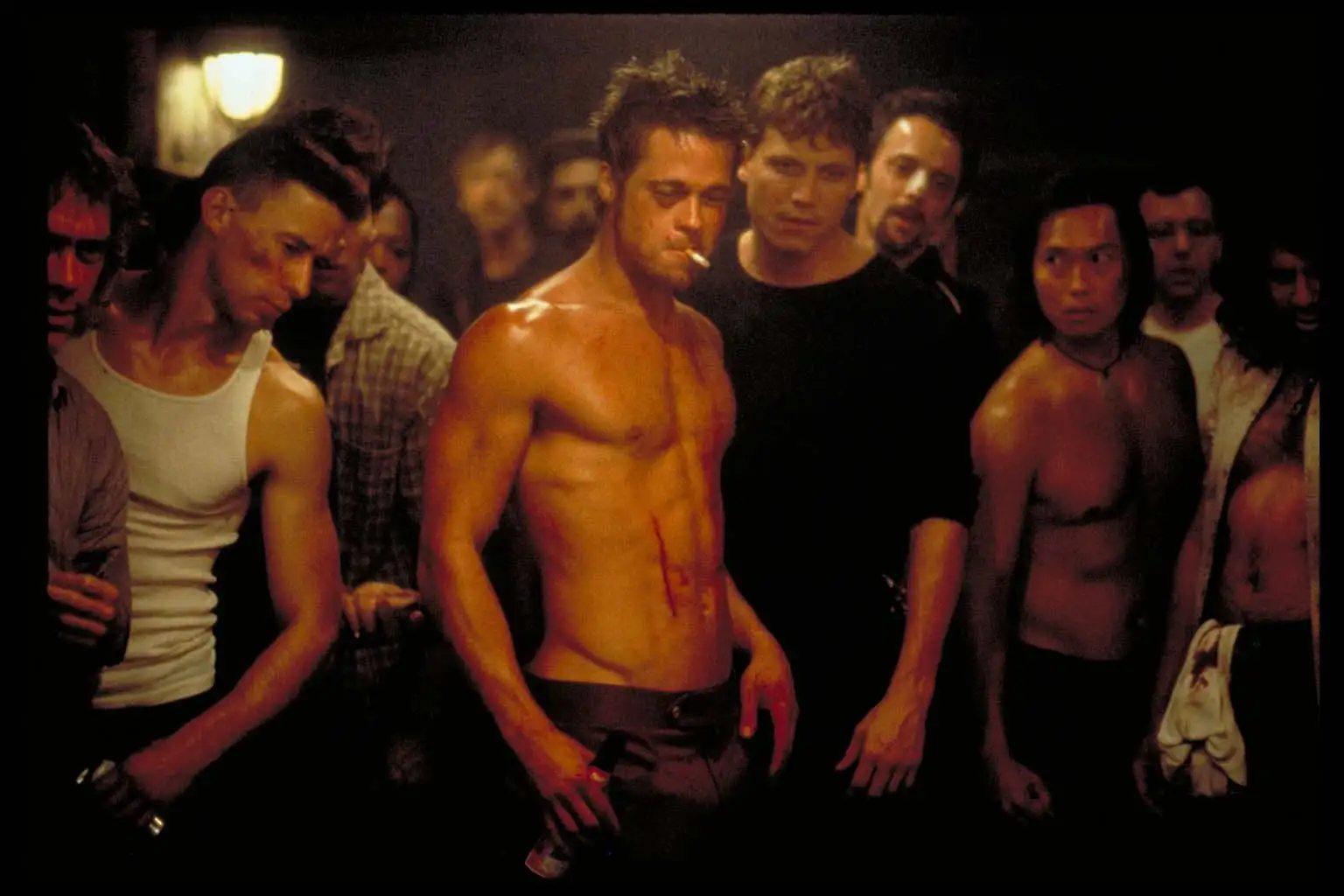By Christian Eltell
Written on October 16, 2017; Published on November 1, 2019
Critic Rating: 4/4 Stars
20th Anniversary Review

When I first saw Fight Club nearly a decade ago, I didn’t know what to think of it. The film was too violent and too complicated for me to understand. After watching David Fincher’s best thrillers, which include Se7en, Zodiac, and The Game, I thought I was able to predict what Fight Club would be about. However, I realized that as I was watching the movie, this wasn’t a regular thriller by Fincher. Initially, I disliked the movie because it seemed like the film was trying to cheaply convey a meaningful message just through the use of violence. I thought the film was attempting to say that violence and chaos were good things to help people get ahead in life. However, when I saw Fincher’s 1999 flick for the second time during an undergraduate film course, I viewed the movie in a more critical sense, and realized that the violence was not used as an excuse to advance the plot. There was more to the film’s message, and the fight scenes did reveal some philosophical meanings.

Fight Club is about an ordinary everyman, played by the versatile Edward Norton. He is also the narrator of this story. Norton’s character has a regular office job, and goes to group therapy sessions in the evenings in order to understand other people’s pain, and to figure out what he really wants in life. He also wants to resolve his conflicts with insomnia. Norton’s protagonist ends up meeting Tyler Durden, portrayed by the energetic Brad Pitt, while on an airplane for a business trip. Tyler makes soap, but he also reveals to Norton’s character the meaning of life, and how a person can take care of his/her self without the need for valuable items like furniture, T.V, a nice house, etc.

While watching Fight Club the first time, I was puzzled by the idea that an underground fight group can be viewed as a therapy session, in order to let out all your fury towards another person. The fight scenes are so hard, raw, bloody, and brutal that it appears men are physically beating each other up for real. What I always enjoyed about the film were the performances. Brad Pitt and Edward Norton work so hard to be convincing in their roles that it looks like they aren’t even acting. Norton’s narrator looks like a man desperately trying to figure himself out. Helena Bonham Carter is Marla, a peculiar female character who also goes to group therapy sessions, constantly wears dark clothes, smokes too many cigarettes, and appears to be in a sexy love triangle between Pitt and Norton’s characters. Meat Loaf brings the acting chops in a hilarious performance as a man with emotional instability, a big appetite, and some funny fighting skills, especially with the use of his chest and tummy. Brad Pitt is the mastermind behind fight club, and would get himself into any fight or risky situation in order to prove a point and to protect the integrity of his group.

Watching the fight scenes during my first viewing of the film made me sick to my stomach, causing me to dislike the movie, even though it was highly regarded as a classic. I couldn’t understand the characters’ motivations, as well as what satisfaction would be gained if men were to beat each other up every night? Fight Club reminded me a lot of Stanley Kubrick’s A Clockwork Orange and Christopher Nolan’s Memento because the protagonist in each film has an identity crisis. In Kubrick’s film, Malcolm McDowell’s Alex is a deranged criminal and rapist who attempts to rehabilitate himself in a mental institution. A Clockwork Orange was also a film I disliked because there were violent scenes, especially a “Singin’ in the Rain” rape scene, that each ran too long, and I had no sympathy for Alex and his cruelty. Even when Alex tries to get better, how can you care for a man who’s had such a troubled history of crimes against humanity? While watching Fight Club, I also thought of Christopher Nolan’s Memento, a film I enjoyed because of its unique narrative style and the way the story is displayed backwards to show how Guy Pearce’s Leonard suffers from short-term memory loss. However, Memento left me confused, causing me to raise questions about the characters. I also felt this way about Fight Club. What goals would be achieved when men fight and punch each other nearly to death?

At first, I thought the purpose of Fight Club was to glorify senseless, brutal violence. However, while watching the movie again during my film class in 2014, I analyzed Fincher’s picture with a critical lens. Fight Club reveals how men use violence as a sense of escapism. Norton’s protagonist and other men hate their day jobs and fight each other in order to express their anger and rage at the world. Brad Pitt’s Tyler Durden talks to his group about how the media and upper-class citizens enjoy taking advantage of normal people, and that they don’t need fancy clothes or elegant cars and houses to get by in life. Durden convinces his group that regular guys can make their own living without being given orders from the government or their bosses at work. Norton’s character laughably punches himself in order to force his boss to give him a raise and work from home, or he will be charged with assault. Another hilariously painful situation is when Durden burns Norton’s hand with acid, to see if he is capable of handling tremendous pain. Durden also allows himself to get beat up by two upper class men in order to show his group that he would protect them by taking a beating. In another scene, Durden’s men confront other privileged citizens by acting obscene and inappropriate during their day jobs.
Watching the film for the second time made me realize that Fight Club was a comedic satire that was making fun of violence, as well as to show how men are fit to survive under any circumstances when they fight for what they need. Pitt and Norton live in an abandoned, worn-out house with a dirty bathroom and broken walls. They smoke cigarettes, make soap, and set up one-on-one fights. They live and act this way because it is their choice and their freedom of expression. I appreciated Fight Club even more the second time around because I found it similar to other 1999 pre-millennial films, such as The Matrix and American Beauty. The characters in each movie discover that they are unordinary people who have a higher purpose and are meant to do more with their lives. In The Matrix, Neo discovers he is “The One” meant to lead a rebel army against evil machines and programmers that want to take over their world. In American Beauty, Kevin Spacey’s protagonist, Lester Burnham, has a crush on a young woman who also likes him because they both know that they are different from ordinary people. Lester hates living a normal life with his boring wife, so he drastically changes his lifestyle by exercising and changing his job. In Fight Club, Tyler Durden and his group live like free men and do what they want with their lives. They set up fights in order to escape ordinary life. In other words, Fight Club is a revolutionary experience that’s set up to prove who fits under Darwin’s theory of evolution: “Survival of the fittest.”

